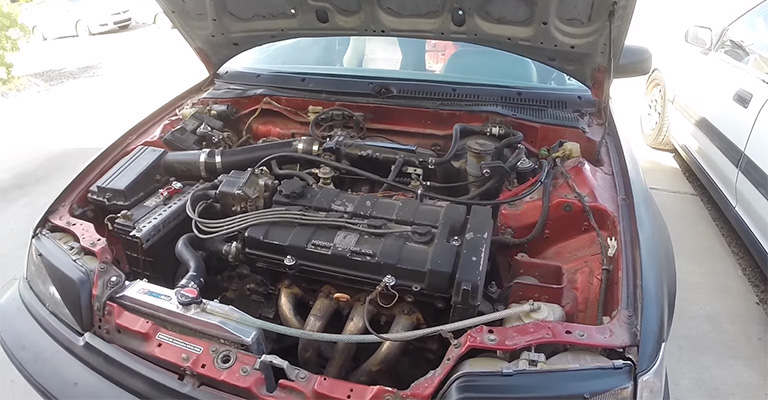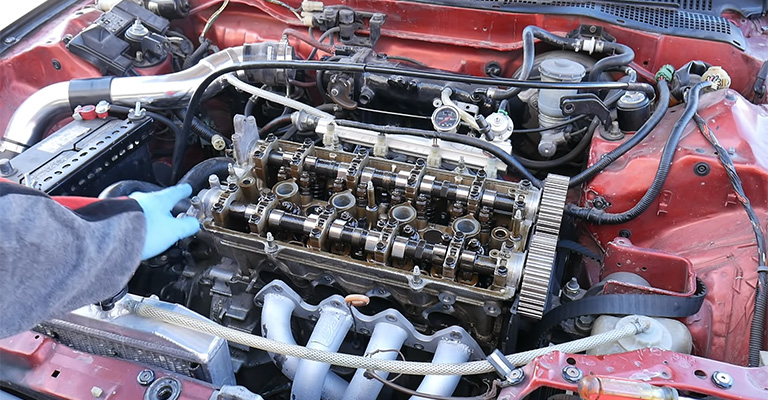The Honda B18A1 engine was first introduced in 1990 and was primarily found in the Acura Integra in the US market. It was part of Honda’s B-series engine family, which was known for its reliability, efficiency, and performance.
The B18A1 engine was equipped with several advanced features, including a programmable fuel injection system, a high redline, and a well-designed cylinder head, which made it a popular choice among car enthusiasts.
In this post, we will be taking a closer look at the key specifications and features of the Honda B18A1 engine, as well as its performance and reliability. We will also compare the B18A1 with other engines in its class to give you a better understanding of its capabilities.
Whether you are a car owner or are considering purchasing a vehicle with this engine, this post will provide you with all the information you need to know about the Honda B18A1 engine.

Honda B18A1 Engine Overview
The Honda B18A1 engine is a 1.8-liter inline 4-cylinder engine that was produced by Honda in the 1990s. It was designed as part of Honda’s B-series engine family, which was known for its reliable, efficient, and high-performance design.
The B18A1 engine was fitted into the Acura Integra in the US market and was available in several different trim levels, including the RS, LS, LS Special Edition, and GS models.
One of the key features of the Honda B18A1 engine was its programmable fuel injection system. This allowed for precise control over fuel delivery, resulting in improved performance and efficiency.
The engine had a compression ratio of 9.2:1 and was capable of producing 130 horsepower at 6000 RPM and 121 lb-ft of torque at 5000 RPM. This made it one of the most powerful engines in its class at the time.
Another highlight of the Honda B18A1 engine was its high redline. The engine was capable of revving up to 6500 RPM, with a rev limit of 7200 RPM. This allowed the engine to produce its maximum power and torque output, making it an ideal choice for high-performance applications.
The engine’s cylinder head was also designed to promote optimal airflow, which helped to improve overall performance.
In terms of dimensions, the Honda B18A1 engine had a bore x stroke measurement of 81 mm x 89 mm and a rod length of 137.01 mm. This gave the engine a rod/stroke ratio of 1.54, which helped to ensure optimal balance and stability at high RPMs.
The engine was paired with either a S1, A1, or cable transmission, depending on the model and trim level.
In conclusion, the Honda B18A1 engine was a highly capable and reliable engine that was well-regarded by car enthusiasts and mechanics alike. Its combination of advanced features, high performance, and efficient design made it a popular choice for high-performance applications.
Whether you are a car owner or are considering purchasing a vehicle with this engine, it is definitely worth considering the Honda B18A1 engine for its performance and reliability.

Specification Table for B18A1 Engine
| Specification | Details |
|---|---|
| Engine Type | 1.8-liter inline 4-cylinder |
| Displacement | 1,834 cc |
| Compression Ratio | 9.2:1 |
| Bore x Stroke | 81 mm x 89 mm |
| Rod Length | 137.01 mm |
| Rod/Stroke Ratio | 1.54 |
| Redline | 6500 RPM |
| Rev Limit | 7200 RPM |
| Fuel Injection | Programmed fuel injection |
| Power Output | 130 bhp at 6000 RPM |
| Torque Output | 121 lb-ft at 5000 RPM |
| Transmission | S1, A1, or cable transmission |
| Found in | 1990-1991 Acura Integra USDM “RS/LS/LS Special Edition/GS” |
Note: These specifications are for reference only and may vary depending on the model and trim level.
Source: Wikipedia
Comparison With Other B18 Family Engine Like B18a1 and B18a2
The Honda B18 engine family was comprised of several different engine models, including the B18A1 and B18A2. Both of these engines shared many similarities, but also had some key differences that set them apart.
Here is a comparison between the Honda B18A1 and B18A2 engines
| Specification | B18A1 | B18A2 |
|---|---|---|
| Engine Type | 1.8-liter inline 4-cylinder | 1.8-liter inline 4-cylinder |
| Displacement | 1,834 cc | 1,834 cc |
| Compression Ratio | 9.2:1 | 8.8:1 |
| Power Output | 130 bhp at 6000 RPM | 125 bhp at 6000 RPM |
| Torque Output | 121 lb-ft at 5000 RPM | 118 lb-ft at 5000 RPM |
| Fuel Injection | Programmed fuel injection | Programmed fuel injection |
| Transmission | S1, A1, or cable transmission | S1, A1, or cable transmission |
| Found in | 1990-1991 Acura Integra USDM “RS/LS/LS Special Edition/GS” | 1990-1991 Acura Integra USDM “LS” |
As you can see, both the B18A1 and B18A2 engines were very similar in terms of their design and specifications. The main difference between the two engines was the compression ratio and the power and torque output.
The B18A1 engine had a higher compression ratio, which allowed it to produce more power and torque than the B18A2 engine.
In conclusion, both the Honda B18A1 and B18A2 engines were excellent choices for those looking for a reliable, efficient, and high-performance engine.
The choice between the two engines ultimately comes down to personal preference and the specific requirements of the application. Regardless of which engine you choose, you can expect outstanding performance and reliability from the Honda B18 engine family.
Head and Valvetrain Specs B18A1
The Honda B18A1 engine was equipped with a DOHC (dual overhead cam) valvetrain system, which consisted of four valves per cylinder. This allowed for improved airflow into the engine and increased power output. The following are the head and valvetrain specifications for the B18A1 engine:
| Specification | Details |
|---|---|
| Valve Configuration | DOHC, 4 valves per cylinder |
| Camshaft Type | Dual overhead camshafts |
| Camshaft Lift | Not specified |
| Camshaft Duration | Not specified |
| Valve Springs | Not specified |
| Retainers | Not specified |
| Rocker Arms | Not specified |
| Pushrods | Not specified |
Note: These specifications are for reference only and may vary depending on the model and trim level. The camshaft specifications are not specified by the manufacturer, but they can be determined through aftermarket sources or engine builders.
The Technologies Used in
The Honda B18A1 engine was equipped with several advanced technologies that improved its performance, efficiency, and reliability. Some of the technologies used in the B18A1 engine include:
1. Dual Overhead Camshafts (Dohc)
The B18A1 engine was equipped with dual overhead camshafts, which allowed for improved airflow into the engine and increased power output.
2. Programmed Fuel Injection (Pfi)
The B18A1 engine was equipped with a Programmed Fuel Injection (PFI) system, which delivered the precise amount of fuel to the engine based on driving conditions and driver inputs. This technology improved fuel efficiency and reduced emissions.
3. Four-valve Design
The B18A1 engine was equipped with four valves per cylinder, which allowed for improved airflow into the engine and increased power output.
4. High-revving Design
The B18A1 engine was designed to rev to high RPMs, which allowed for improved power and performance.
5. Lightweight Construction
The B18A1 engine was constructed from lightweight materials, which reduced its weight and improved its power-to-weight ratio.
These technologies, combined with Honda’s engineering expertise, made the B18A1 engine a high-performance and reliable choice for drivers who demand the best from their engine.
Performance Review
The Honda B18A1 engine was a high-performance engine that was well-regarded by drivers and enthusiasts. With its dual overhead camshafts, four-valve design, programmed fuel injection, and high-revving design, the B18A1 engine provided strong power and performance.
In terms of power, the B18A1 engine produced 130 horsepower at 6000 RPM and 121 lb-ft of torque at 5000 RPM. This power was delivered smoothly and consistently, making the B18A1 engine a great choice for both daily driving and high-performance driving.
The B18A1 engine was also designed to rev to high RPMs, which allowed for improved power and performance. The redline for the engine was 6500 RPM and the rev limit was 7200 RPM, which gave drivers plenty of room to explore the engine’s high-performance capabilities.
In addition to its strong performance, the B18A1 engine was also praised for its reliability and durability. Honda’s engineering expertise and use of high-quality materials helped ensure that the B18A1 engine would provide many years of trouble-free driving.
Overall, the Honda B18A1 engine was a highly-regarded choice for drivers who demanded strong performance, reliability, and durability from their engine.
Whether you were a daily driver or a high-performance enthusiast, the B18A1 engine provided the power, performance, and reliability you needed.
What Car Did the B18a1 Come in?
The Honda B18A1 engine was found in the 1990–1991 Acura Integra USDM (United States Domestic Market) in the following models:
- RS/LS/LS Special Edition/GS (DA9 Liftback/Hatchback)
- DB1 Sedan
These vehicles were equipped with the B18A1 engine, which provided strong power and performance for drivers who demanded the best from their engine.
B18A1 Engine Most Common Problems
The most common problems with the B18A1 engine include
1. Oxygen (O2) Sensor Failure
This can cause poor fuel efficiency and a decrease in performance.
2. Distributor Failure
This can cause issues with ignition timing and misfires.
3. Mass Airflow Sensor (MAF) Failure
This can cause the engine to run rich or lean and can trigger a check engine light.
4. Ignition Control Module (ICM) Failure
This can cause issues with spark timing and misfires.
5. Vacuum Leaks
This can cause issues with engine performance and fuel efficiency.
6. Excessive Oil Consumption
This can be a sign of worn piston rings or cylinder walls.
It’s important to diagnose and repair these issues promptly to prevent further damage to the engine.
Upgrades and Modifications Can Be Made
Upgrades and modifications can be made to improve the performance of a vehicle. Common modifications for the B18A1 engine can include upgrading the intake and exhaust systems, adding a high-flow fuel pump and injectors, installing a performance camshaft, and adding a turbocharger or supercharger.
These modifications can help to increase the engine’s power and improve its overall performance. However, it’s important to keep in mind that making significant upgrades to a vehicle can often result in increased maintenance costs, and may also void the manufacturer’s warranty.
Other B Series Engines-

Leave a Reply